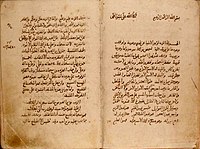
Photo from wikipedia
This study was performed to visually analyse the relationship between particles and oil in seawater by digital holograph technology. Two types of particles with different sizes were chosen to form… Click to show full abstract
This study was performed to visually analyse the relationship between particles and oil in seawater by digital holograph technology. Two types of particles with different sizes were chosen to form oil-particle aggregates (OPAs) in the laboratory to determine whether these particles may be a good approach to safely and harmoniously recover marine environment after an oil spill. The processes were recorded by a digital inline holographic system, which could facilitate a continuous real-time three-dimensional in situ observation of oil droplets and OPAs without touching these particles. The visual results showed that, in the micro scale, the particles formed two different types of OPA after breaking the oil film and transported oil into the bottom of the water, while some OPAs could be resuspended.
Journal Title: Geosciences Journal
Year Published: 2018
Link to full text (if available)
Share on Social Media: Sign Up to like & get
recommendations!